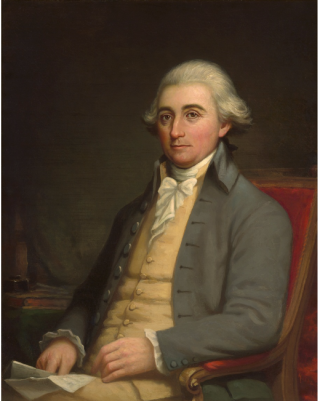Museum

Jonathan Trumbull Junior, pictured above (ca. 1800) while serving as Governor of Connecticut, was one of the four sons of Revolutionary War Governor Jonathan Trumbull Senior. During the war, Jonathan Jr. served as Paymaster General for the northern department of the Continental Army, as the first Comptroller of the U.S. Treasury, and as military secretary to General George Washington from 1781 to 1783. He was a representative in the first Congress elected under the new Constitution in 1789 and the second Speaker of the U.S. House of Representatives. He then served in the U.S. Senate but resigned to return to Connecticut to become lieutenant governor in 1796. In 1797 Jonathan Trumbull Jr. was elected Governor of Connecticut, serving until his death in office in 1809.
Jonathan Trumbull Junior's Georgian-style house was probably built sometime in the early 1760s by his father, Jonathan Trumbull Sr. Jonathan Jr. and his bride Eunice Backus of Norwich were living in the house at least by 1767, the year they were married, although Jonathan did not purchase the house from his father until 1777. He then hired master joiner Isaac Fitch of Lebanon to remodel the house. Isaac Fitch carved the elaborate woodwork and paneling in the downstairs rooms and the cherry bannister that curves along the stairway to the second floor. A kitchen ell and an extension to the north parlor were also added.
Historians generally agree that this was the house where General Washington stayed the night of March 4-5, 1781, when he passed through Lebanon on his way to Newport, R.I., to meet with General Rochambeau. Rochambeau was the leader of the French army sent by Louis XVI to help the United States in its battle for independence from Great Britain. After the war, Jonathan Jr. added a colonnade or piazza across the second story of the house in imitation of Mt. Vernon, which he had visited with Washington and Rochambeau in the fall of 1781.
After the death of Jonathan Trumbull Jr. in 1809, his widow maintained the property until 1814 when it was sold out of the family. During a span of 240 years, different owners remodeled the house to suit their own needs, reflecting many of the social and technological changes occurring in the nation at large. Hands-on tours and exhibits illustrate these changes and tell a fascinating story of the interaction between a house and the people who made it their home.
Each of the families that owned the house-Trumbull, Armstrong, Babcock, Holbrook, Spencer, Crandall, Palmer, Hewitt, and Rockwood-brought the personal tastes and needs of their respective generations to the house and remodeled it accordingly. The colonnade was added and removed, front windows lowered, rooflines changed, stoves installed in fireplaces, stairways relocated, ells enlarged, porches added, and indoor plumbing and electricity installed.
Despite all these changes, Isaac Fitch's intricately carved woodwork remained untouched. In 1977 rumors circulated that a nationally known museum was interested in purchasing the two parlors with the best examples of Fitch's work and removing them to New York. The town's benefactor, Hugh Trumbull Adams, stepped in to save the historic house and provided funds for the town of Lebanon to purchase the house. It was restored to the time of its most prominent owner, Jonathan Trumbull Jr., and furnished with reproductions of 18th-century furniture typical of his time and life style. The 1978 restoration reflects the Colonial Revival style adopted by preservationists of Hugh Trumbull Adams's generation and is an important part of the story of the house that visitors see today.
Visitors can also explore the story of Jonathan Trumbull Jr.'s long public career, which included service on both the state and national levels from the beginning of the Revolutionary War through the early years of the new Republic. They can learn about his wife, Eunice Backus of Norwich, who ran the household during her husband's long absences from home. Their three daughters, Faith, Harriet and Maria, were born and grew up in this house but their father's political power and wealth gave them connections with a wider world. Their marriages indicate the cosmopolitan nature of their upbringing: Faith married Daniel Wadsworth, founder of the Wadsworth Atheneum; Harriet married Benjamin Silliman, first professor of chemistry at Yale University and a founder of the Yale Medical School; and Maria married Henry Hudson, son of the publisher of the Hartford Courant.
Lebanon was the center of Connecticut's extraordinary contributions to the American Revolution. Explore this site to find the other museums and historical sites around the Lebanon Green, known as the "Heartbeat of the Revolution." Lebanon was the home of William Williams, Signer of the Declaration of Independence, and Governor Jonathan Trumbull Senior, the only Colonial governor to become the governor of a state when Independence was declared. Over 500 meetings of the Council of Safety were held in the governor's War Office on the Green. The governor's four sons, Joseph, Jonathan Jr., David and John, the famous painter of the Revolution, were all ardent supporters of the patriot cause.
Lebanon was also the site of the seven-month encampment of Lauzun's Legion, the cavalry unit of the French army led by General Rochambeau. The Legionnaires camped in the fields west of the Green and baked their bread in ovens built on the Green. And it was here, on the historic town Green, that General Washington reviewed the French troops during his visit in March 1781.
Lebanon is the major site on the Northeast Connecticut Visitors District "Revolutionary Road" drive and the gateway to the Quinebaug-Shetucket National Heritage Corridor, an affiliate unit of the National Park Service. It is part of the Washington-Rochambeau Revolutionary Route (W3R) that is currently being studied by the National Park Service for National Historic Trail status.

